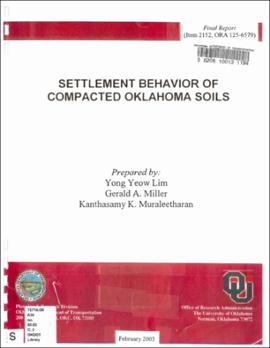| dc.description.abstract | Numerous highway embankments experience post-construction settlement problems, such as bridge approach settlement that results in the "bump at the end of the bridge." One of the causes may be wetting-induced collapse settlement or simply, collapse settlement. Collapse settlement is a time-dependent process resulting from post-construction increases in moisture content. The post-construction settlement of numerous Oklahoma highway embankments raised questions as to whether the current Oklahoma Department of Transportation embankment specifications and construction practices are adequate in addressing collapse settlement, and prompted the current study to examine the influence of soil type on collapse potential of Oklahoma soils. One-dimensional oedometer tests were conducted to study the potential for collapse settlement of22 Oklahoma soils and shales under conditions typically encountered in compacted fills. Results show that factors related to fine composition, such as clay-size fraction, plasticity index, liquid limit, activity, and AASHTO group index can be used for preliminary estimation of collapse index. Statistical analysis of the oedometer test data indicates that variables having the most impact on collapse index are moisture content, dry unit weight, plasticity index, and clay-size fraction. Settlement charts were developed to facilitate the estimation of collapse settlement of fills for different conditions, including fill height, moisture content, and soil type. Three scale centrifuge models compacted at different conditions and a case history of an embankment that has experienced significant collapse settlement are presented. Predictions based on one-dimensional oedometer-based method and settlement charts are compared to measured collapse settlements at the embankment centerlines. Given the uncertainty with field estimates of settlement, the comparison showed a reasonable agreement between predictions and field estimates of collapse settlement at the embankment centerlines; the limited evidence suggests that predictions based on one-dimensional assumptions tend to underestimate actual settlements possibly due to the two-dimensional nature of embankments. The review of literature regarding settlement of compacted fills, the laboratory test results obtained, and the field study of an actual embankment suggest the need for embankment design and specifications that will account for collapse susceptibility of different soil types. Specifications should demand for exceptional quality control and more stringent compaction requirements during embankment construction, particularly for large embankments, collapse-susceptible soils, and embankments susceptible to flooding. | |
